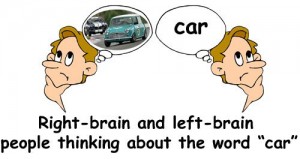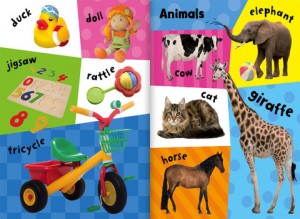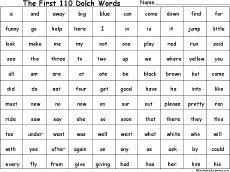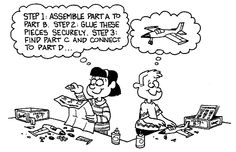I believe there might be a misconception about how a creative, right-brained person learns to read with sight words. From my understanding, when the words “sight words” comes up at school, most often what is being referred to are those words that have to be learned “by sight” because the words don’t follow phonics rules. A lot of these words are those found in the Dolch word list. This focus has nothing to do with how a creative child learns to read with sight words.
Let me explain the attributes found in a creative, right-brained child that influences how a right-brained child learns to read. This person is a picture-based learner. That means everything is translated to a picture. Numbers are translated  to pictures. (1+1=2 translates to one dog plus one cat equals two animals; very relevant by the way, in math, because one tractor plus one dog doesn’t equal two animals.) And words are translated to pictures. This means these learners have a highly developed visualization skill. Right-brained people “picture” things in their minds. This is why sight word reading, initially, can be successful for them. It’s using their strength of visualization.
to pictures. (1+1=2 translates to one dog plus one cat equals two animals; very relevant by the way, in math, because one tractor plus one dog doesn’t equal two animals.) And words are translated to pictures. This means these learners have a highly developed visualization skill. Right-brained people “picture” things in their minds. This is why sight word reading, initially, can be successful for them. It’s using their strength of visualization.
What is the best way to start using a sight word focus to help a right-brained child to learn to read? With words that can be translated to pictures! We want to use their strengths of visualization for their steps into reading. Repetitive picture books are a good place to start. For example, Brown Bear, Brown Bear has a lot  of picture translatable words, such as color words, animal words, and a few verb words. Children’s picture dictionaries or the first 100 word books are also great places to start. Actually, these are great for self-teaching! Labeling objects around the house is another way to achieve this.
of picture translatable words, such as color words, animal words, and a few verb words. Children’s picture dictionaries or the first 100 word books are also great places to start. Actually, these are great for self-teaching! Labeling objects around the house is another way to achieve this.
Why do these resources and strategies work? Here’s the typical process for learning words for a creative child: They see a word, they form a picture in their head that represents the word, and then they put that word under that visual picture in their mind. Here’s an interesting phenomenon that can happen sometimes that indicates this procedure. When silent reading, an early reader may come across the word “sofa.” They recall the picture representing “sofa” in their minds, but under the picture of “sofa” is “couch.” The first time they encountered that word, and translated it into a picture, it was with the word “couch,” so that’s what got put there. They naturally sometimes use the same picture for a synonym. Instead of saying the word “sofa” when they read it aloud, they say “couch.” The person listening may find that confusing, but when you understand the process of how they learn to read, it can make perfect sense. Over time, these types of translation “glitches” work their way out.
Let’s talk about what a typical sight word program might do instead. It might focus on the Dolch words since these represent the 220 most common words  used in learning to read. The theory is if you know these words well, you can learn to read better and faster. The problem for a right-brained child is that many of these words don’t translate well to pictures. For instance, think of these Dolch words: the, of, has, were, or is. As we watch our creative child learn to read, and struggle with these “simple” words, we are flabbergasted since we know our child is smart. Why isn’t he getting this simple word? Because, for a right-brained learner, simple words may be hard and hard words may be easy. It’s actually all relative to how you process information!
used in learning to read. The theory is if you know these words well, you can learn to read better and faster. The problem for a right-brained child is that many of these words don’t translate well to pictures. For instance, think of these Dolch words: the, of, has, were, or is. As we watch our creative child learn to read, and struggle with these “simple” words, we are flabbergasted since we know our child is smart. Why isn’t he getting this simple word? Because, for a right-brained learner, simple words may be hard and hard words may be easy. It’s actually all relative to how you process information!
Let me conclude by explaining that I think most fluent readers use both sight word and phonics to read. But, I think each child should begin with the method that capitalizes on his or her strengths, and then add in the other. Schools begin with phonics at 5 and then add in the Dolch word sight word list afterward. For a left-brained child, who is a word-based learner, reading is right up their focus area because another strength skill is sequential thinking. Phonics is a good fit, initially, because it utilizes both the strength of word-based thinking and sequential ordering. These are also universal gifts for left-brained learners, so it fits into the right timeframe for them. For right-brained children, learning reading skills at 5 doesn’t fit the universal gifts of a right-brained child (picture-based thinking and extraordinary imaginations). However, their gifts needed to be successful in reading (visualization skills and a mind full of images) are ripe at the second brain development stage starting at 8 years old. Thus, many right-brained children learn to read between 8 and 10 years old.
There is a well-matched reading theory for each type of brain processing preference. Starting with phonics for left-brained children at 5 and following up with the Dolch sight word list can work well for them. Starting with a sight word focus for right-brained children using picture-based words such as nouns, verbs,  and adjectives at 8 and following up with phonics can work well for them. These individualized focuses also support each of the brain processing preferences of whole-to-part learning versus part-to-whole learning. Left-brained people tend to prefer part-to-whole. Give me the parts (phonics) and I can figure out the whole (sight). Right-brained people tend to favor whole-to-part learning. Give them the whole (sight) and they can understand the part (phonics). It only makes sense that there are different ways to successfully learn to read as well as different timeframes to do the same.
and adjectives at 8 and following up with phonics can work well for them. These individualized focuses also support each of the brain processing preferences of whole-to-part learning versus part-to-whole learning. Left-brained people tend to prefer part-to-whole. Give me the parts (phonics) and I can figure out the whole (sight). Right-brained people tend to favor whole-to-part learning. Give them the whole (sight) and they can understand the part (phonics). It only makes sense that there are different ways to successfully learn to read as well as different timeframes to do the same.
We are all built uniquely with brain processing preferences to match. You can’t convince me that there is only one right way to learn to read or when to read, just like there isn’t one right way to learn math, to learn a foreign language, or to learn music or when. When we individualize learning to fit the child versus make the child fit the environment or the curriculum or the scope and sequence, we find most children not only come to learn the skill joyfully, but with a positive relationship to the subject intact. Take the leap of faith; your child has everything to gain!
If you benefited from this content, please consider supporting me by buying access to all of my premium content for a one-time fee of $15 found here. This will even include a 50% off e-mail link toward a copy of my popular The Right Side of Normal e-book (regularly $11.95)!






Pingback: The Natural Learning Development for Right-Brained Children | The Right Side of Normal
Pingback: Dyslexia or Right-Brained Dominant? | The Right Side of Normal